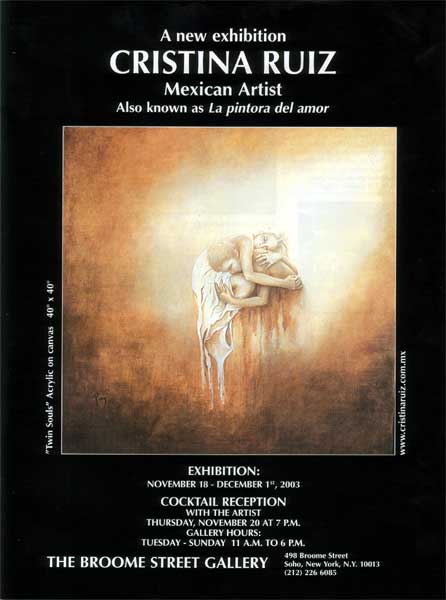Revista Gallery & Studio
Noviembre 2003

Cristina Ruiz: Mexico's Messenger of Love Triumphant
Almost exactly one year ago, the young exican painter Cristina Ruiz made her New York City debut with an impres¬sive exhibition in Soho. Critics were espe¬cially struck by Ruiz's ability to capture a mood of youthful romance without resorting to sentimentality. Still, to have won over the cynical New York cognoscenti with paintings so unabashedly in love with love was no small victory. For while Poets are given license to indulge in matters of the heart, painters are expected to seduce us by visual means alone.Cristina Ruiz, however, is a good enough painter to ignore such rules. Known in her own country as "La pintora del amore," her first New York solo show depicted willowy young women entranced by reveries or entwined with their lovers, and these taboo subjects were realized with such exquisite aesthetic means as to charm even the most romantically chal¬lenged critics.
Cristina Ruiz's second solo exhibition in the same venue, Broome Street gallery, 498 Broome Street can be seen from November 18 through December 1, with a reception for the artist on Thursday November 20, at 7 PM. And make no mistake about it: You will find that romance is still on the menu, to para¬phrase the old song. But at the same time, something new has entered into Ruiz's work as well. This might best be described as an intensification of the sur¬realist element which was present in Ruiz's previous exhibition and which is prevalent in Mexican art in general, hav¬ing been prominent in the work of Frida Kahlo and other historical role models. In Ruiz's paintings, however, surrealism and romanticism have merged more thor¬oughly, creating a highly successful syn¬thesis unique to this artist.
And the effort that it must have taken to meld these two tendencies so seamless¬ly and imbue a somewhat more daring compositional approach with a necessary verisimilitude has apparently caused Ruiz to perfect her technical abilities as well. At least this appears to be the case, judging from the prowess that she now brings to her realist technique, employing acrylics on canvas with a degree of refinement that can often resemble egg tempera for its luminous glowing surface and tonal subtlety.
Whereas in her earlier paintings, Ruiz danced gingerly upon the fine line between drawing and painting, she has now integrated her drawing skills much more thoroughly with her painterly abili¬ty, getting under the skin of her figures, so to speak, in a manner that makes her compositions more dramatic and believ¬able, even as she dares ever more surreal effects.
Color, especially, has come more into its own in Ruiz's new paintings. While still employing predominantly warm earthy tones in emulation of the Old Masters, Ruiz reveals a greater diversity of nuances, of luminous highlights and subtle second¬ary hues that imbue her canvases with del¬icate atmospheric qualities which make her backgrounds as sensuous as her fig¬ures are sensual. Indeed, figure and ground relationships are now more fully integrated; Ruiz's skillful management of light and shadow enlivens her composi¬tions with a dramatic sense of chiaroscuro suggesting that she has been taking les¬sons from Rembrandt and Caravaggio.
In any case, the heightened atmospheric qualities in Cristina Ruiz's newest paint¬ings add a new dimension of drama that enhances their surreal content, creating a sense of metaphysical realms and stratos¬pheric spaces for her lovers to inhabit. They do so weightlessly, as though float¬ing in dreamy auras, as seen in her large acrylic on canvas "Light of Love," where the male figure is seen within a circular shape suggesting a large soap bubble. He gazes down yearningly at the female fig¬ure, reclining languorously within a more rectangular shape, her nude body bent back, full breasts thrust upward as though in the throes of passionate reverie. Between the two softly diffused geometric forms that the figures inhabit, a mysteri¬ous beam streams, shattering a length of chain suspended in space.
As in certain paintings by the Italian contemporary artist Francesco Clemente, it is Cristina Ruiz's ability to create a sub¬tly modulated painterly environment via her exquisite refinement of the surface that enables her to juxtapose disparate symbolic elements and make them cohere compositionally in "Light of Love," as well as in another major acrylic on canvas called "Cover Me With Your Love." Like the former painting this composition is forty inches square, the symmetry of the format enhancing the sense of limitless space in which the two figures are poised. Here, the female nude inhabits the fore¬ground and is seen only from the breasts up, emerging Venus-like from a body of water which vanishes into the softly mod¬ulated ground, in which subtle variations of red, violet, and yellow-inflected earth colors create dramatic lights and darks. Above the beautiful blond woman, a male figure in a loincloth is seen splashing her with water from a classical jug hoisted onto his shoulder, symbolically anointing her with his love, as indicated in the title. The jug glows with more light than any reflection from the sun could logically provide, suggesting a numinous rather than physical object, a vessel of love lit from within.
Although the smaller scale of the male figure suggests that he is kneeling some¬what further back on the shore, the absence of any landscape definition in the atmospheric ground gives the impression that he is hovering angelically in mid-air, yet another expression of the sacredness with which the artist regards romantic love. This sense of reverence merges with profound sensuality in yet another new painting called "Twin Souls," its simpler composition depicting two lovers embrac¬ing in a halo of heavenly light blazing from the surrounding darkness.
Like her great predecessor Frida Kahlo, Cristina Ruiz paints from the depths of the female soul. Unlike Frida, however, Cristina is no victim, no martyr to love. Rather, she is its triumphant messenger.
Maurice Taplinger